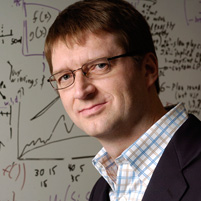Saving Lives

Patients waiting for a kidney transplant were matched with living kidney donors recently through a computer algorithm developed at Carnegie Mellon University.
The pairing happened as the national Organ Procurement and Transplantation Network (OPTN), operated by the United Network for Organ Sharing (UNOS), began a national pilot program to increase the number of kidney paired-donation (KPD) transplants.
"A unified nationwide exchange can yield significantly better solutions than multiple separate exchanges, and it is extremely rewarding that after we have worked on this for six years, the nationwide program is now live," said Tuomas Sandholm, a Carnegie Mellon professor of computer science who has led the development of computer algorithms for optimizing match runs.
The initial run of the computer matching process included just 43 kidney transplant candidates and 45 potential living donors. A national KPD pool, however, could eventually include as many as 10,000 donor-recipient pairs.
Each pair includes a potential donor who is not medically compatible with his or her original intended recipient, or is less than an optimal match. In the matching process, the computer looks for new combinations between the pairs based on compatible blood and tissue types.
For example, in a two-way exchange, the donor from one pair is matched with a compatible recipient from a second pair, while the donor from the second pair is matched with the recipient from the first pair. Three-way exchanges also were calculated in the initial run.
Establishing a national pool could boost kidney transplants because as the size of the exchange pool grows, the chances of finding compatible matches increase.
In the last three years, exchanges have enabled more than 700 kidney transplants that otherwise would not have occurred. Two of those exchanges have used the Carnegie Mellon computer algorithm to match pairs.
The pilot program's initial computer run on Oct. 27 successfully matched seven people who need kidney transplants with medically compatible individuals who agreed to donate a kidney.
Two of the seven candidates were highly sensitized because of previous exposure to donor antigens, which can make it particularly difficult to find donors with compatible tissue types.
"We are grateful both for Dr. Sandholm's expert consulting in developing our national pilot program and for the use of Carnegie Mellon's algorithm," said OPTN/UNOS President Charles Alexander. "These contributions have helped us develop the program more quickly and at significantly lower cost than we could have achieved otherwise, so we can focus on saving and enhancing lives through kidney paired-donation."
The need to increase the efficiency of kidney exchanges is compelling. The demand for donor organs — more than 86,000 people are now on the kidney waiting list — far exceeds supply. Last year, 28,463 people received kidney transplants, with 6,609 of those kidneys coming from living donors.
Pictured above is Tuomas Sandholm, a Carnegie Mellon professor of computer science.
Photo: Tuomas Sandholm, a Carnegie Mellon professor of computer science, is literally saving lives with his algorithms.
Related Links: School of Computer Science | Pay It Forward
